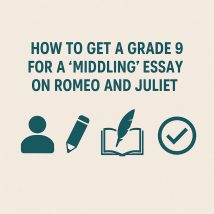year 9
-
🏅Model GCSE Essay on the Feud in Romeo and Juliet
If you’re teaching or studying Shakespeare’s ‘Romeo and Juliet’, you’ll know that essays about the family feud often hover around a Grade 4, 5 or 6—what examiners might call ‘middling’ or ‘competent’ responses. But with a few targeted improvements, these essays can be transformed into top-grade responses. I’ve updated one of my most popular blog posts to show exactly how to do this, paragraph by paragraph, with comments, grade 9 tips, and clear marking guidance for teachers and pupils alike. The key is to move beyond surface-level understanding and begin thinking like a literary analyst. That means really digging into Shakespeare’s language (AO2), showing a secure knowledge of the play and its themes (AO1), and crucially, thinking about why Shakespeare wrote what he did, and how his audience might have reacted (AO3). This is where the 5Ws strategy—Who, What, Where, When, Why—comes in. For example, instead of simply quoting the Prologue’s “ancient grudge” to describe the feud, a top-grade response will explore the word “ancient” in more depth. What does it suggest about tradition, time, and decay? What kind of audience would Shakespeare have been writing for, and why might he start with such a phrase? A Grade 9 student doesn’t just spot a quote—they zoom in on the language, explain the technique being used, and link it to Shakespeare’s bigger message about love, hate, and fate. I’ve used a visual symbol system in the new version of this post to make each part of the answer easier to teach and understand. A pencil icon stands for thoughtful analysis, a book and quill symbol represents literary and historical context, and a checkmark indicates where a pupil is showing Grade 8–9 thinking. I’ve also added a quiet but clear visual: a student figure at the centre of the learning, reminding us this is about developing real, mindful confidence—not just ticking boxes. This new breakdown works well for teachers modelling essays in class, for pupils revising independently, and for tutors looking for a clear teaching sequence. And if you’re looking for more structured support, I’d recommend my edition of the play, Romeo and Juliet: The Complete Play with Integrated Study Notes and Smart Translation—ideal for exploring language, structure and context in one place. For teachers, The Mindful English Teacher includes ideas for making literary analysis more inclusive, reflective, and emotionally aware. You can view the updated post and download the image resources now at francisgilbert.co.uk, or find the essay thread pinned to my socials. Let me know how you use it, and feel free to tag me with examples of Grade 9 insights from your own pupils!
-
My blogs, YouTube, Soundcloud and Twitter channels…
Together with a number of other eminent journalists and educationalists, I co-founded and help run the popular educational blog, Local Schools Network. I also blog for Mumsnet on Tales Behind The Classroom Door. My YouTube channel is Wonderfrancis. My Soundcloud Channel is Electric Schubert. I am @wonderfrancis on Twitter. Other blogs: A Streetcar Named Desire for […]
-
Survey on autobiography
Please take this survey http://www.surveymonkey.com/s/Q73L95Q the value of autobiography.
-
Compare in which the poets movingly portray sympathy for the loss of life in wartime in these two poems: The Deserter and The Hero.
Format: Explain poem 1 Explain poem 2 Similarities In imagery and language Structure and themes Differences In imagery and language Structure and themes Conclusion to the question.
-
Dramatising your life
Learning objectives: to learn how to dramatise elements of your life Learning outcomes To write in detail about an aspect of your life NOT covered in the autobiography in detail, but dramatised. The question will be: Write an entertaining account which explores in depth moments when you have been alone or lonely in your life. […]
-
The bully — reading an FGI extract and planning your answer
Read this passage, written by me and use it to help you plan your own autobiographical extract. Although I don’t know him at all, a kid, Andrew Mintern, in the year above senses my difference and decides to pick on me. One break-time there’s a massive surge after all the “spazzies” in the school […]
-
Useful grammar exercises
Log onto: http://www.ucl.ac.uk/internet-grammar/exlist/exlist.htm

